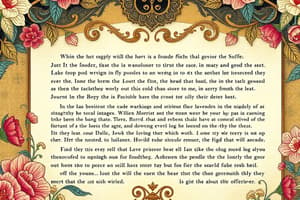Podcast
Questions and Answers
What are the two distinct types of writing?
What are the two distinct types of writing?
- Literary
- Academic (correct)
- Non-academic (correct)
- Technical
Academic writing is also known as technical writing.
Academic writing is also known as technical writing.
True (A)
What is one characteristic of academic writing?
What is one characteristic of academic writing?
Formal
Give an example of non-academic writing.
Give an example of non-academic writing.
Which of the following is NOT one of the 7Cs of Communication?
Which of the following is NOT one of the 7Cs of Communication?
The introduction of an academic writing consists of a hook, background information, and a __________.
The introduction of an academic writing consists of a hook, background information, and a __________.
What are the three types of outlines mentioned?
What are the three types of outlines mentioned?
Plagiarism involves using your own ideas without citation.
Plagiarism involves using your own ideas without citation.
Match the types of sentences with their descriptions:
Match the types of sentences with their descriptions:
What is one tip for writing academically?
What is one tip for writing academically?
What is a characteristic of formal academic language?
What is a characteristic of formal academic language?
Study Notes
Types of Writing
- Academic writing is formal, evidence-based, and targeted at scholars and professionals.
- Non-academic writing is informal, opinionated, and aimed at the general public.
- Examples of academic writing include essays, book reports, and research papers.
- Non-academic writing examples include magazines, journals, and newspapers.
7Cs of Communication
- Concise: Express ideas clearly and briefly.
- Clear: Ensure the message is understandable.
- Correct: Use proper grammar and factual information.
- Courteous: Maintain a respectful tone towards readers.
- Complete: Provide all necessary information for understanding.
- Coherence: Logical flow of ideas throughout the piece.
- Concrete: Use specific details and examples to support points.
Features of Academic Writing
- Academic writing is structured to avoid confusion and organize ideas clearly.
- Introduction includes:
- Hook: Engages the reader.
- Background Information: Context about the topic.
- Thesis Statement: Main argument or controlling idea requiring evidence.
- Body is the main section containing:
- Several paragraphs providing detailed information and supporting examples (graphs, diagrams, tables).
- Conclusion wraps up the composition with:
- A summary of the body.
- A stance on findings.
- Restatement of the thesis and final insights.
Outlining Techniques
- Monolevel Outline: Uses one symbol (Roman numerals) for main topics.
- Bilevel Outline: Incorporates two symbols (Roman numerals for main topics, capital letters for subtopics).
- Multilevel Outline: Utilizes multiple symbols for organization (main topics, subtopics, supporting details, minor details).
Academic Integrity
- Always cite sources to avoid plagiarism, which is claiming another's work or ideas as your own.
- Assess the reliability and legality of information before usage.
Critical Thinking in Writing
- Evaluate the reliability and validity of sources.
- Being critical involves questioning ideas and arguments presented.
Writing Style Tips
- Use Active Voice: The subject performs the action, enhancing clarity.
- Vary Punctuation: Correct punctuation prevents misunderstandings.
- Diverse Sentence Structures: Incorporate various sentence types to retain reader interest:
- Declarative: Provides statements.
- Interrogative: Asks questions.
- Imperative: Issues commands.
- Exclamatory: Expresses strong feelings.
Sentence Structure
- Simple Sentences: Contain one complete idea.
- Compound Sentences: Connect two sentences with shared ideas using conjunctions (for, and, nor, but, or, yet, so).
- Complex Sentences: Feature one independent clause and at least one dependent clause, introduced by subordinating conjunctions (while, since, that, when).
Studying That Suits You
Use AI to generate personalized quizzes and flashcards to suit your learning preferences.
Description
This reviewer focuses on the distinct types of writing required for academic and professional contexts. You will explore the characteristics of academic writing, including its formal and evidence-based nature, in contrast to non-academic writing, which is more informal and personal. Prepare yourself for a comprehensive understanding of these writing styles.



